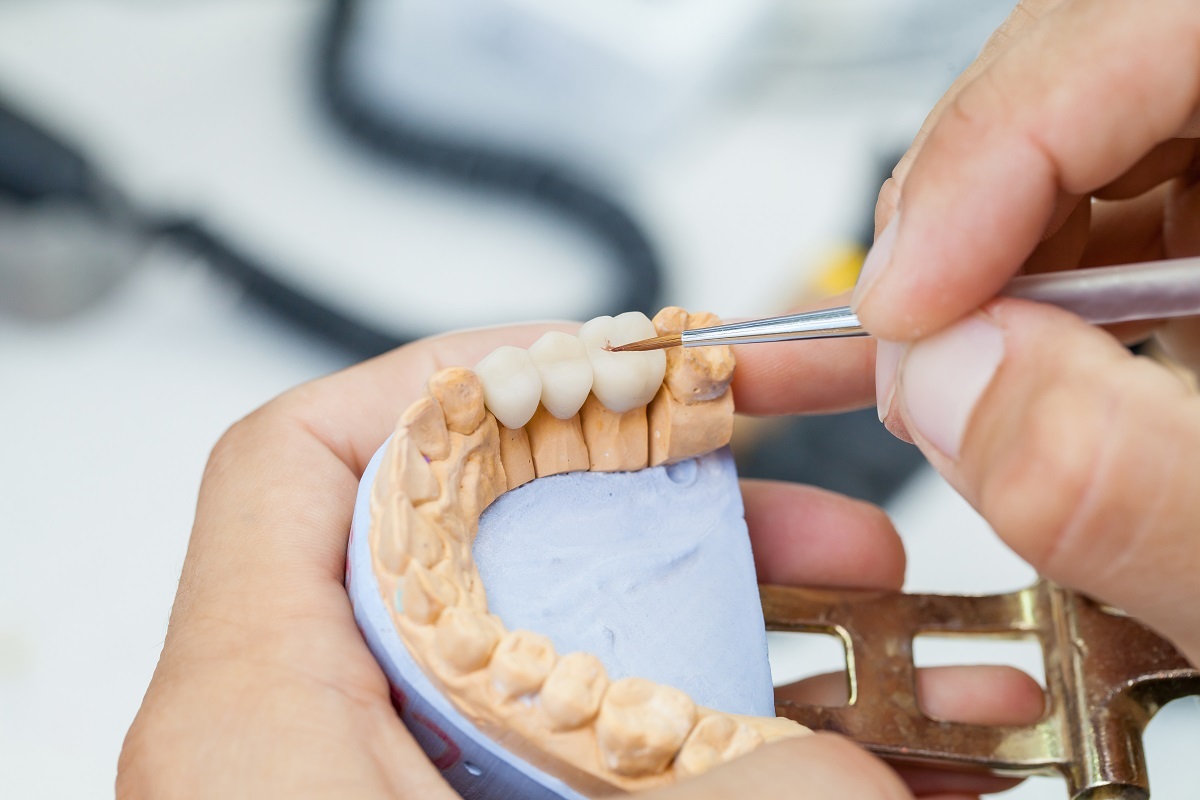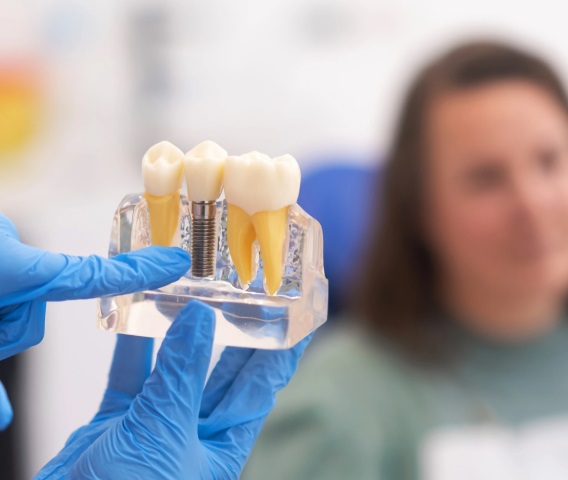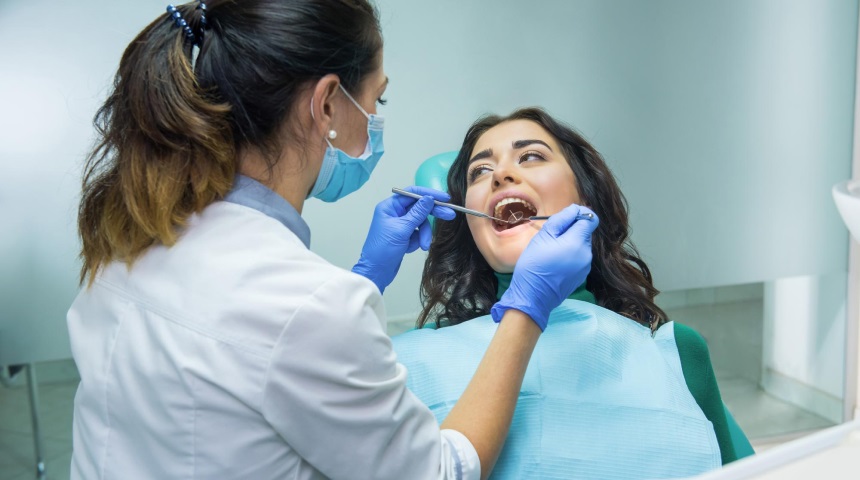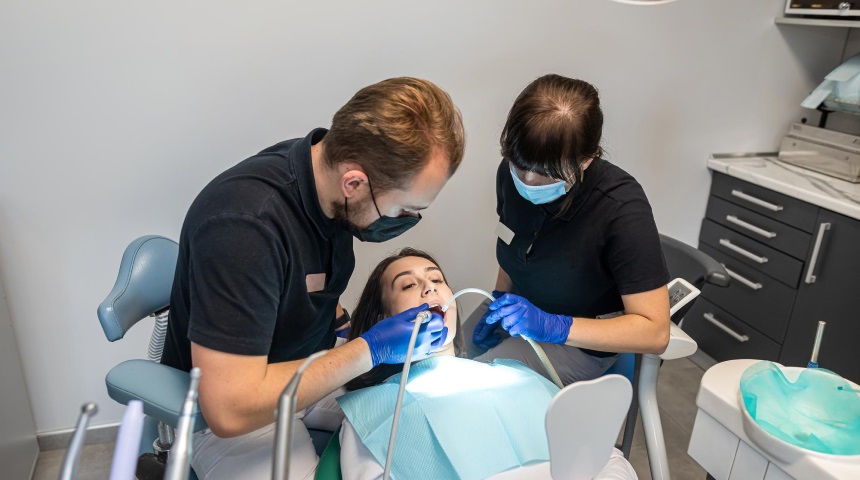General Dentistry
Dental Implants
Scottsdale Dental Implants: The Best Way to Replace a Missing Tooth
Considering tooth replacement options? Dr. Wiitala in Scottsdale, AZ offers dental implants for a perfect smile. Many Americans are missing teeth, with over 178 million missing at least one and more than 35 million missing all their teeth, according to recent ADA statistics. The ideal solution is a dental implant, the best option for single-tooth replacement or anchoring fixtures for multiple teeth. Contact Dr. Eric Wiitala at (480) 657-6981 to see if you’re a candidate for Dental Implants!


What is a dental implant?
A dental implant is a prosthetic replacement for a missing tooth. That tooth may have already been missing or may need to be extracted due to extensive decay that precludes saving the tooth. Implants are actually named for the screw-shaped anchoring piece, the implant, which is made of titanium and is screwed down into the socket of the former tooth root. Once the implant is placed into the jawbone, the bone grows around it and integrates the implant into the jawbone naturally. A post is then attached and a false tooth atop it. Then the implant behaves exactly like a natural tooth.
Why should I bother to replace a missing tooth?
A missing tooth is more than just a gap in your teeth. Beyond the embarrassing look of a gap in your smile, a missing tooth can cause whistling when you speak. Also, missing molars can create problems with chewing, making the person avoid certain foods.
More important are two physical problems. When a tooth is missing, the adjacent teeth tend to slide over into the missing space because there is no longer any pressure keeping them in place. This creates serious bite and alignment problems.
Also, there is a tremendous amount of force applied downward into the jaw when biting and chewing. This bite force transfers energy through the tooth into the jawbone holding it. This energy stimulates the jawbone to continually regenerate; without this energy, the jawbone in that area begins to deteriorate and reabsorb.
Candidates for dental implants
Jawbone mass is the main factor when Dr. Wiitala decides if a person is right for an implant. As noted above, a missing tooth leads to jawbone mass loss in the bone beneath the missing tooth or teeth. If the person has left a missing tooth or teeth unattended for years, the bone loss in the jaw can dictate the need for jawbone grafting to build up the jawbone enough to support an implant.

Benefits of dental implants
Because dental implants basically become a part of your jawbone, they look and function exactly like a natural tooth. You can eat whatever you want. You can bite into hard or sticky foods. You care for the artificial tooth just as you do your natural teeth. Plus, because the titanium implant base is anchored in the jawbone, implants transfer bite force energy down into the jawbone just as natural teeth do. This is important for keeping the jawbone healthy and constantly regenerating new bone mass. Finally, implants are the longest lasting dental prosthesis, usually lasting for the remainder of the patient’s life.
For people with normal jawbone mass, however, virtually anyone of any age is a good candidate for an implant. Any other dental issues such as gum disease must be addressed prior to any implant procedure.
How is an implant placed?
The first step in the implant process is a consultation with Dr. Wiitala. He will perform a full oral exam and take a set of x-rays to determine your jawbone mass. Once he decides your jawbone is strong enough, he moves on to the implant placement, which has four steps.
1. Placement
Dr. Wiitala places the titanium implant, which is shaped like a screw, into the socket of the former tooth root. A small amount of drilling may be required, but otherwise, the implant is screwed down into place.
2. Osseointegration
Now we simply wait to let your jawbone grow around and accept the implant. This is called osseointegration and takes from three to six months.
3. Abutment
When the jawbone has fully accepted the implant, you return and a small metal post called an abutment is attached to the implant. Your gum tissue is then allowed to heal around the abutment for approximately six more weeks.
4. Crown
The final step is to attach the custom-made false tooth (crown) onto the abutment. Once this is placed the procedure is complete and you are ready to go. No recovery is needed.

Is the procedure painful?
It’s easy to assume that drilling down into the jawbone, cutting the gums, and the other steps involved in placing a dental implant would be painful. Truth is, the process is less painful than a tooth extraction. First, Dr. Wiitala uses a local anesthetic during the procedures, so you’ll be awake, but will feel nothing. Second, the jawbone doesn’t have any pain-sensing nerves, so drilling and placing the implant into the jawbone don’t involve any pain.
Afterwards you will have some discomfort, possibly in the chin, cheeks, even underneath the eyes. There may be some bruising. An icepack can reduce the swelling, while ibuprofen is usually sufficient to deal with any aching or pain.
Caring for your implant
Since an implant feels and functions exactly like a natural tooth, your care is no different. Simple brushing and flossing is all that is required. Of course, if decay was your original problem, you’ll need to step up your home hygiene routine.
How long do implants last?
Implant duration is tied to how well you care for them. But if you are attentive to your home hygiene and have twice-yearly professional cleanings and exams your implant can last the rest of your life.
Do dental implants need to be replaced?
Dental implants are meant to be permanent replacements, lasting the remainder of the patient’s life. Of course, there can be exceptions, especially in cases where home hygiene is lacking. Generally, however, implants do not need replacing…ever.
Are teeth implants safe?
Dental implants have the highest success rate of all dental prostheses, over 95 percent. Dental implants have been placed all across the globe and have proven to be incredibly safe and the most effective method for replacing a missing tooth.
What are alternative treatments to dental implants?
Dr. Wiitala believes dental implants to be the single best option for replacing a missing tooth or teeth. Replacing many teeth with implants, however, may be cost prohibitive. In those cases, a bridge or partial denture may be a better solution.
Are there alternatives to dental implants?
Alternatives to dental implants would be fixed bridges or removable bridges/partial dentures. Obviously implants are the premium way to go but not everyone is a candidate for implants. A fixed bridge is typically the second best choice for most patients.
Cost of dental implants
There is no simple answer to the cost of dental implants, as specific pricing depends on several factors. When determining price, some factors Dr. Wiitala considers are if the patient needs a bone graft, how many implants are needed, and if a surgical guide needed for precise placement. Additionally, a patient’s insurance can influence how many dental implants cost to the patient. Ultimately, the best way to determine how much dental implants cost for you is to consult with your dentist who can look at your specific needs and condition.
Schedule Your Dental Implant Consult In Scottsdale, AZ!
Call the office of Dr. Eric Wiitala to schedule your Scottsdale dental implant consultation and see how dental implants can benefit you, (480) 657-6981 . You can also read more on dental implants and our other offered services on Eric Wiitala, DDS’s blog!
Kind Words From Proud Patients
Great staff and Dr. Wiitala is very professional and personable
Dr Wiitala and his staff are the best – friendly, professional and knowledgeable. My family has been going to Dr Wiitala for a decade or more. It’s the best dental office ever.
Professional, excellent experience as always. Dental hygienist, Andrea thoroughly cleaned my teeth and Dr. Wiitala identified filling in need of repair before it would become a major problem down the road. This is reason I’ve been a client of Dr. Wiitala for 15+ years.
I had not been to the Dentist in quite awhile but broke a crown. Dr. Wiitala and his staff were tremendous! They were able to get me in quickly. At the appointment, everyone was friendly and professional. They communicated to me every step of the way and were able to perfectly correct my issue in a quick and painless manner! I would highly recommend Dr. Wiitala and his staff. They all were terrific!
Thank you again to Dr Wiitala and his great staff for their skilled dental care. I had my teeth cleaned by Lindsey who does a superb job, keeping my comfort in mind. I highly recommend this dental office for all your dental needs.
